|
Honda Civic
Debut: 2006
Maker: Honda
Predecessor: Civic Mk7
|
|
Civic
used to have a
special status in my mind. I can easily remember each of the 7
generations Civic ever lived, from the ’73 Mk1 with CVCC combustion
technology to the ’01 Mk7 with Hybrid power unit. Innovative
technologies distinguish it from Western competitors while dynamic
image separates it from Japanese rivals. Simultaneously, it has all the
user-friendliness, reliability and build quality that characterize
Japanese cars, no wonder it is one of 3 best selling cars in the world,
beside Toyota Corolla and Volkswagen Golf.
The 8th generation Civic, like the outgoing generation, is divided into
2 versions - the Japanese / American version and the European version.
The European version is a 5-door hatchback while the Japanese /
American version is a conventional 4-door sedan, plus a 2-door coupe.
This reflect the different taste of different countries. Moreover, the
European car got a shorter wheelbase and a more compact torsion-beam
rear suspensions instead of the 5-link setup. They do share similar
styling and high percentage of components, but the different size,
suspensions and chassis tuning resulted in somewhat different
character. We had better to report separately... |
| The
above report was last updated on 28 Jan
2006. All Rights Reserved. |
Civic (Europe)
|
 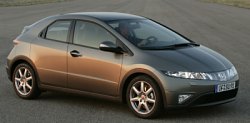
Design
The first one grabbing my attention is the striking new look.
Unquestionably, the new Civic is a very radical design. It is a one-box
wedge shape with fast-angle windscreen and tailgate. Obviously, Honda
wants it to look like a coupe, so they made the rear doors small and
hide the door handles at the window frames in Walter de Silva style
(see Alfa 156 and Seat Leon). Unfortunately, this design is too
"front-heavy". It concentrates all the visual mass at the nose,
resulting in an unbalanced profile. Is it striking? yes. Beautiful?
maybe not.
Cabin
Inside,
the visual effect is again striking. A radical double-layer
dashboard has the digital speedometer at upper level while the rev
counter and other readings at the usual position. The idea was to keep
the driver vision closer to the road when he read the speedometer, but
to shorter drivers the speed reading could be blocked by the steering
wheel rim.
A
glance at the car's dimension will find it is actually smaller than
the last generation (surprise!), being 35mm shorter, 35mm lower and
more significantly, 45mm shorter in wheelbase. Does this reduce cabin
room? undeniably, yes. This is partly because the old European Civic
5-doors was so jumbo (remember, no other C-segment cars came close to
its 2680mm wheelbase). In fact, the new Civic is competitively sized,
thus it offers competitive space in the cabin. Generally speaking, the
cabin is as roomy as Ford Focus and Volkswagen Golf. Surprisingly,
although it looks like a coupe, its rear seats actually offer good head
and legroom, while a flat floor pleases the middle passenger.
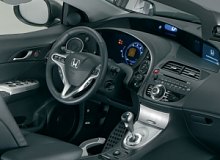  
When
analyzing the packaging of new Civic, one should pay attention to
its center fuel tank. Learning from Fit (Jazz), the Civic has its fuel
tank positioned under the front seats. This liberate the space under
the rear seats, thus when the rear seats flip up it can accommodate
very tall cargos in the cabin.
The question is, how useful is this feature? especially the center fuel
tank has two drawbacks - 1. the front seats need to be mounted high,
thus the driver will find his head close to the steeply raked
windscreen. 2. There is no foot room under the front seats for the rear
passengers to stretch. Sacrificing these two comfort indicators for a
rarely used cargo carrying capability, is this worthwhile?
Chassis
Remember the days Honda Civic used to be proud of having
double-wishbone suspensions all round? since last generation things
started changing, or more precisely, a degradation process. Initially,
it switched to MacPherson struts up front and a double-wishbone-based
multi-link setup at the rear. Now Honda thinks the rear suspension is
too space wasting, incompatible with its "cargo room is everything"
concept, thus simply replaced it with a conventional torsion-beam axle.
The traditional supporters of Civic must be shocked.
I guess
you know what torsion-beam
axle is. It is a kind of
semi-independent suspension which link up the two wheels by a twist
beam. Very simple, very cheap and space saving. Unfortunately, there is
no free lunch in the world. When you ask for accurate wheel control and
independent bump absorption, there is no replacement for a
double-wishbone suspension or a multi-link suspension. For this reason,
Ford Focus switched to multi-link in 1998. It stunned the world by its
excellent ride and handling, eventually drove many other cars to
follow. This include its sister car Mazda 3 and the most significant
player in the class, Volkswagen Golf, and its sisters Skoda Octavia and
Seat Leon / Toledo / Altea.
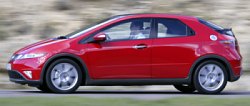 In my opinion, Honda is taking
a big gamble here. To reduce the risk,
it tried to compensate with other improvements, for example, wider
tracks and lower height should improve cornering stability, while the
shorter wheelbase - the European Civic has shorter wheelbase than its
American / Japanese sister - should aid agility. It also tuned the
springs and dampers sportier than the past. The electric power steering
is geared at a very quick 2.29 turns lock-to-lock. Steering feedback is
also improved to match Golf, if not the electro-hydraulic-steered Focus. In my opinion, Honda is taking
a big gamble here. To reduce the risk,
it tried to compensate with other improvements, for example, wider
tracks and lower height should improve cornering stability, while the
shorter wheelbase - the European Civic has shorter wheelbase than its
American / Japanese sister - should aid agility. It also tuned the
springs and dampers sportier than the past. The electric power steering
is geared at a very quick 2.29 turns lock-to-lock. Steering feedback is
also improved to match Golf, if not the electro-hydraulic-steered Focus.
On the road, the Civic does feel quite sporty. Fine body control, grip,
braking and steering make it more fun to drive than those cars with
similar suspensions, say, Renault Megane, Citroen C4, Peugeot 307 and
Opel Astra. But the multi-link camp - Ford Focus, VW Golf and Mazda 3 -
still had an upper hand, especially in ride quality. On B-roads, the
Civic displays poor low-speed ride, transmitting a lot of jiggle and
noise into the cabin. Had it got an independent rear suspension, this
would not have happened.
Powertrain
The European Civic employs all 6-speed gearbox, either manual or
automated manual. 3 choices of engines are available at launch. The
cheapest engine is Fit (Jazz)'s 1.3-litre sohc 8V twin-spark i-DSI
engine. Its 83hp output means acceleration is nothing but leisure.
The highlight engine is a new 1.8-litre sohc 16V with i-VTEC variable
valve timing and 2-stage intake manifolds. It adopted a new VTEC
concept to reduce fuel consumption. Under light load, the i-VTEC system
delays the intake valve timing to reduce the air enter the combustion
chamber. This means the throttle can remain wide open thus reduce
pumping loss. The concept is not unlike BMW's Valvetronic. Honda claims
it consume 1.5-litre class fuel while produce 2.0-litre class power -
some 140hp and 128lbft. Well, the power claim might be a little
exaggerate, considering a Golf 2.0 FSI produces 150hp and 147lbft.
At low rev, the i-VTEC engine feels no more punchy than other 1.8-litre
class engines. It needs rev to realize the claimed horsepower. Luckily,
this is aided by a slick-shifting 6-speed manual gearbox and a smooth
and light clutch, all in the tradition of Honda. Working hard, Autocar
magazine proved that you can accelerate the car from 0-60 mph in only
8.2 second. 100 mph is reached at 25.2 seconds, matches Golf 2.0 FSI.
Unfortunately, doing so is both tiresome and unbeneficial to fuel
consumption. Moreover, the 1.8 i-VTEC engine is not one of the most
refined Honda engines. Cruising steadily on highway at 80 mph, the
engine is intrusively noisy.
That leave us to the most expensive engine - the 140hp 2.2-litre turbo
diesel engine. Its power delivery is on the contrary to the 1.8 petrol.
It produces 251 lbft of torque from as low as 2000 rpm, so performance
is strong and flexible. However, the installation in Civic is far from
successful, as it produces much more noise than in Accord.
Bottom Line
So, which engine is pick of the range?
Well, this question doesn't matter anymore, because you can easily see
the new European Civic is not our pick of the class. Its look delivers
a mixed impression. Its handling is good but not exceptional. Its ride
quality is seriously compromised on poorer roads. Performance is one
dimensional. Refinement is ruined by the noisy engines, both petrol and
diesel. Outstanding cargo carrying capability is achieved in the price
of comfort. And do you need to be reminded that it costs even more
money than the very desirable Golf ? |
| The
above report was last updated on 28 Jan
2006. All Rights Reserved. |
Civic (America and Japan)
|
 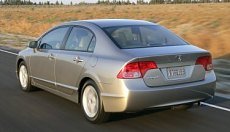
If the European Civic
looks too
aggressive for you, then the Japanese / American Civic sedan must be
more comfortable to your eyes. It looks rounder and more civilized.
Compare with the outgoing generation, the evolution towards cabfoward
and monospace design is obvious - doesn't it look very much like a
Japanese Honda Odyssey MPV from the front?
Equally obvious is the upgraded build quality and enlarged volume. The
new Civic no longer looks like a small econo car, but more like an Opel
Vectra class vehicle. Such observation is supported by tape measures -
the wheelbase has been stretched by 80 mm to a class-leading 2700 mm,
actually matching Opel Vectra ! body width has gained another 30 mm,
while kerb weight has increased by 70-80 kg. So you must expect more
space and comfort from the cabin?
The answer is both yes
and no. Up front, occupants will find plenty of
headroom, legroom and shoulder room. Furthermore, the spacious feel is
amplified by the forward-mounting windscreen, although this is not
necessarily related to sitting comfort. Like many cabfoward cars,
forward vision is hampered by the "miles away" windscreen while the
thick yet steeply raked A-pillars create serious blind spots. The
double-level dashboard is similar to the European Civic but the shape
of the plastic molding is less stylish. Some people like the digital
speedometer placed at the upper level because this let them concentrate
attention closer to the road ahead. Some others find it difficult to
adapt to when they turn their vision from the speedometer to
tachometer, not only because of the long distance separating them but
because the drivers will have to recalibrate their mind from digital
scale to analogue scale. Calling it an "ergomomics disaster" might be
too strong, but at least Volvo's engineers won't design cars like this.
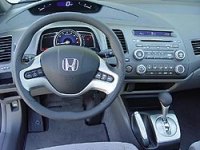 At the back, passengers won't
find more room than the last generation.
In fact, rear legroom is actually reduced slightly, so is the trunk
space. We really don't know how Honda spent the extra wheelbase. It is
no where as spacious as its exterior size suggested. Anyway, there is
no problem to accommodate two 6-footers at the back, and it still
boosts a flat rear floor. At the back, passengers won't
find more room than the last generation.
In fact, rear legroom is actually reduced slightly, so is the trunk
space. We really don't know how Honda spent the extra wheelbase. It is
no where as spacious as its exterior size suggested. Anyway, there is
no problem to accommodate two 6-footers at the back, and it still
boosts a flat rear floor.
One fundamental
difference between the Japanese / American Civic sedan
and the European Civic hatch is the rear suspensions. While the
European car employs a simple torsion-beam, the Japanese / American car
retains the sophisticated 5-link setup from the last generation (Honda
claims it a double-wishbone plus a trailing arm). This explain why it
needs 65 mm longer wheelbase than the European hatch to realize the
same rear passenger space. However, the fully independent suspensions
should benefit ride quality. Can it avoid the negative comments of the
European Civic?
Yes, partly because of the suspension design, partly because of the
more comfort-oriented tuning, the Civic sedan rides smoothly and
quietly. However, it has traded some of the old car's agility for
refinement, blame to the extra weight and size. Sadly, Civic used to be
the most driver appealing econo cars in the eyes of American
journalists. Now they bias towards Mazda 3.
Mazda also has a bigger 2.3-litre engine to please the torque-hungry
American. In contrast, Civic offers one and only one engine - the same
140hp 1.8-litre i-VTEC as the European car. Honda claims it produce
2-litre class horsepower and drink as little fuel as 1.6-litre class.
The fact is, it doesn't produce 2-litre class torque, especially from
low to mid-range. Furthermore, when it produces 2-litre class
horsepower it returns 2-litre class fuel consumption and motorcycle
class noise level.
Mated with a 5-speed manual gearbox instead of the European car's
6-speeder, the Civic sedan cannot repeat the remarkable performance of
the latter. Mechanical refinement is disappointed by the slightly
notchy gearshift, considering the high standard Honda's gearboxes
usually achieved.
Ironically, the Japanese / American Civic sedan and European Civic
hatchback use different approaches to get the same result - they do not
perform as good as their revolutionary look suggested. None of them are
class leaders.
Ever since the establishment of JCOTY (Japanese Car of the Year) award,
every generation Civic had won this title (in 1984, 1989, 1992, 1996
and 2001 respectively). Unfortunately, this year the latest generation
finished
only the 4th place. It must be a big blow to Honda, if not
a big surprise to us. |
| The
above report was last updated on 13 Feb
2006. All Rights Reserved. |
Civic Hybrid
|
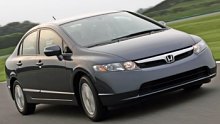 As
everybody knows, hybrid technology was pioneered by Toyota Prius in
1997, but Honda also had significant contribution to the technology. In
1999, Honda launched its own IMA hybrid power system in the Insight
coupe. IMA used electric motor to assist acceleration and to regenerate
electricity during deceleration. Unlike Toyota's system, it was not
capable to run in pure electric mode, but this allowed it to use
smaller electric motor and battery pack to save costs and space - two
decisive factors for mass production. While Toyota was still making
every Prius at an undisclosed loss, Honda produced the first
commercially viable hybrid car in 2002, Civic Hybrid. As
everybody knows, hybrid technology was pioneered by Toyota Prius in
1997, but Honda also had significant contribution to the technology. In
1999, Honda launched its own IMA hybrid power system in the Insight
coupe. IMA used electric motor to assist acceleration and to regenerate
electricity during deceleration. Unlike Toyota's system, it was not
capable to run in pure electric mode, but this allowed it to use
smaller electric motor and battery pack to save costs and space - two
decisive factors for mass production. While Toyota was still making
every Prius at an undisclosed loss, Honda produced the first
commercially viable hybrid car in 2002, Civic Hybrid.
In my opinion, Civic Hybrid was actually more advanced than Prius
because it successfully integrated hybrid powertrain into a mass
production model. In the Prius, you sacrificed some driving dynamics
normally associated with other cars. You paid more money (which could
be hardly returned by the savings in fuel cost during the life of the
car) yet Toyota still made loss. In contrast, in Civic Hybrid people
enjoyed the same driving manner and practicality as other Civics. By
sharing all parts with other Civics excluding the power system, one can
see Civic Hybrid cost less money to build than Prius.
In reality, the original Civic Hybrid was not a commercial success. As
Renault-Nissan's Carlos Ghosn pointed out, to consumers, the fuel
savings of hybrid cars did not justify the higher purchase price; to
manufacturers, the sales of hybrid cars did not justify the investment
costs. Those buying hybrids were likely to be environmentalists and the
niches. They wanted to be noticed about their commitment to reduce
greenhouse gas, so they would rather choose Prius over Civic Hybrid,
which was hardly visually distinguishable from ordinary Civics.
Entering the second generation, Civic Hybrid hopes to raise sales to
20,000 units a year. That is only a fifth of what Toyota Prius targeted
for 2006. However, Honda did not want to break away from its existing
theory. From outside, you cannot tell whether this is a Hybrid or an
ordinary Civic sedan. Because the new Civic is smoother and more
aerodynamic efficient than the last generation, there is even no need
for extra aerodynamic kits.
 As
before, the IMA power system consists of a 1.3-litre petrol engine and
a brushless DC motor, mated to a CVT to optimize energy efficiency. The
electric motor is very thin and laminated between the engine and CVT.
Now it has been uprated from 13hp to 20hp, accompany with double
torque. This allow the new car to run
purely on the electric motor for the first time under some
conditions, say, when it is cruising leisurely below 35 mph. As
before, the IMA power system consists of a 1.3-litre petrol engine and
a brushless DC motor, mated to a CVT to optimize energy efficiency. The
electric motor is very thin and laminated between the engine and CVT.
Now it has been uprated from 13hp to 20hp, accompany with double
torque. This allow the new car to run
purely on the electric motor for the first time under some
conditions, say, when it is cruising leisurely below 35 mph.
For mild acceleration, Civic Hybrid runs the engine only. If it need
stronger acceleration, the engine and motor work simultaneously to
provide maximum push. When the car is cruising at high speed, only the
engine runs. When the car decelerate, the electric motor regenerates
electricity and recharges the Ni-MH batteries. It goes without saying
that hybrid cars can save energy because they recapture the braking
power for use at other time. Another fuel-saving technology is the
automatic start-stop function. When the Civic Hybrid come to a stop,
say, stop before traffic light, the engine shuts down automatically to
save fuel. Once the driver press the throttle pedal, it restarts
immediately.
As seen from its SOHC 8-valves design, the 1339cc engine is apparently
designed to reduce friction and maximize fuel efficiency. Unlike
the 1339cc engine used in Fit / Jazz, this engine got a very special
3-stage VTEC system - one set of cam lobes is for low rev, another set
is for high rev and the last set is to de-activate the valves. By
shutting down all cylinders when the engine is not in use (say, during
deceleration or at low speed cruising by electric motor), the engine
can avoid wasting energy to suck in and pump out air. In other words,
it eliminates what engineers called "pumping loss". In deceleration,
the elimination of pumping loss results in more energy returned to the
battery.
The engine produces 95 horsepower and 91 lbft of torque. Combine with
the electric motor, maximum output becomes 110 horsepower and 123 lbft,
representing a 20% improvement from the old car. When the battery is
full, Car & Driver found it took 10.8 seconds to accelerate from
0-60 mph and 37.6 seconds to 100 mph, both were slightly quicker than
Toyota Prius (11.3 sec and 39.6 sec respectively). However, when
compare performance figures with other cars, you have to consider when
the battery is not fully charged. As Car & Driver measured, a
half-full battery will lengthen the acceleration time considerably to
12.3 sec and 41.4 sec respectively. The longer you drive it in
enthusiastic mode, the less likely you get a full battery.
Like Prius, Civic Hybrid claims very favourable fuel consumption
figures: 87.5 mpg according to JIS standard and 61.4 mpg according to
EU combined cycle. However, EPA of the USA found only 50 mpg while many
journalists and owners will tell you in real world driving you can get
just over 40 mpg, assuming you are not enthusiastic driver. Apparently,
typical AutoZine readers can easily dip below 40 mpg. If you do a lot
of highway cruising, the hybrid won't deliver much advantage over
regular cars, because its fuel saving is mainly achieved by
acceleration-deceleration.
That bring us back to the basic question: is the Civic Hybrid really
worth the 15% extra price over a regular Civic? Put it straight, if you
have no environmental consciousness in mind, you can forget it, for its
poorer performance and high price do not justify the real world fuel
savings.
If you care about global warming, the Civic Hybrid is unquestionably a
fine choice, but there are better alternatives, such as the latest
European diesel cars. They offer comparable performance, fuel
consumption and carbon-dioxide emission at much lower prices. If you
are a hardcore environmentalist, then I would recommend a diesel Smart
Fortwo. It drinks 25% less fuel than the Civic Hybrid and speaks louder
than Toyota Prius to the observers.
However, if you are resident in the North America, until now your
choice is limited to Civic Hybrid and Prius. Both cars have their
strengths and weaknesses. Civic Hybrid has a more solid chassis,
leagues better handling dynamics and quieter cabin. It shares the same
high-level of quality and refinement with other Civics. On the down
side, its cabin is not as roomy as Prius and it does not feel any more
special or innovative than the regular Civic. This mean the biggest
threat actually comes from other Civics. |
| The
above report was last updated on 16 Feb
2006. All Rights Reserved. |
Civic Coupe and Si
|
 Traditionally,
Civic Coupe was exclusively offered for the North America, whose people
prefer coupes to hot hatches. The latest generation is no exception.
Naturally, the 2-door coupe is built in the United States together with
the 4-door sedan. Compare with the sedan, it is 50 mm shorter in
wheelbase and 70 mm lower. The fastback rear screen confined rear
headroom, making it less sensible than a hot hatch. Traditionally,
Civic Coupe was exclusively offered for the North America, whose people
prefer coupes to hot hatches. The latest generation is no exception.
Naturally, the 2-door coupe is built in the United States together with
the 4-door sedan. Compare with the sedan, it is 50 mm shorter in
wheelbase and 70 mm lower. The fastback rear screen confined rear
headroom, making it less sensible than a hot hatch.
Mechanically, there is not much separating the coupe and sedan, as they
share the same suspension setting, the same engine and transmissions.
Apparently, people buy the coupe mainly for looks. However, it is hard
to call a MPV-style monospace coupe as stylish. Park it beside a Toyota
Celica and you'll see what I mean.
Anyway, the highlight of Civic Coupe is the Si. This high-performance
model will be available in sedan form as well, but the slightly lighter
and lower coupe is probably a better home to the high-performance
mechanicals.
So, what is Civic Si ? you can
think in this way: it is the American version of Civic Type R. In the
past 5 years, American boy racers must be upset that they were not
offered the Type R. In fact, they were denied with the last two
generations Type R. As "pocket rockets" have become increasingly
popular in recent years, Honda finally agreed to bring Type R
performance to the America, albeit in the name of Si. Basically, the Si
employs all the goodies from the last generation Type R, such as a 200
horsepower i-VTEC 2-litre engine, a close-ratio 6-speed gearbox,
Helical limited slip differential, quicker steering rack, sports
suspensions and stronger brakes.
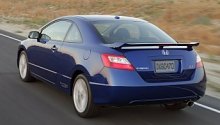 Jewel of the crown is the 8000
rpm engine. Apart from the addition of smooth-running balance shafts,
this engine is basically identical to the ones used in the previous
Civic Type R and Integra Type R / Acura RSX Type S. Its i-VTEC system
has a cam phaser to vary valve timing continuously according to rev,
plus a cam-changing VTEC system which switch to high-lift, long-opening
duration cam lobes at around 6000 rpm. The engine then goes wild,
screaming and revving into another zone. At 6200 rpm, the max torque
139 lbft arrives. 7800 rpm sees the release of all 197 horsepower - 3
horses down from the old engine but this is mostly due to the new SAE
testing method. Jewel of the crown is the 8000
rpm engine. Apart from the addition of smooth-running balance shafts,
this engine is basically identical to the ones used in the previous
Civic Type R and Integra Type R / Acura RSX Type S. Its i-VTEC system
has a cam phaser to vary valve timing continuously according to rev,
plus a cam-changing VTEC system which switch to high-lift, long-opening
duration cam lobes at around 6000 rpm. The engine then goes wild,
screaming and revving into another zone. At 6200 rpm, the max torque
139 lbft arrives. 7800 rpm sees the release of all 197 horsepower - 3
horses down from the old engine but this is mostly due to the new SAE
testing method.
Unlike its turbocharged or supercharged rivals, the high-revving Honda
engine is short of torque. But playing with its short-throw,
slick-shifting 6-speed gearbox to keep the engine boiling is fun and
exciting. Also, short of torque means there is no torque steer at all.
The stiffer suspensions keep body roll well checked in corners, the
215/45 tires provide good grip, while the electric power steering
provides decent feel and precision. Ride quality remains acceptable.
Work hard, you can get 0-60 mph done in 6.8 seconds and 0-100 mph in
16.8 seconds. That's serious performance for a 2-litre naturally
aspirated machine. Unfortunately, most rivals now adopt superchargers
or turbochargers to deliver even stronger acceleration. Chevrolet
Cobalt SS, for example, can cut 1.5 seconds from its 0-100 mph time.
But what disappoints is that the new Si has not brought any progress. 5
years ago the Type R could already do 0-60 in 6.7 seconds and 0-100 in
16.2 seconds. It was 100 kg lighter than the new car while additional
suspension tower braces ensured its chassis at least as stiff as
today's car. The hatchback Type R was more accommodating and practical
to use as well. Its dash-mounted gearstick was more user friendly. It
looked
prettier too....
Perhaps this is why Honda determined to call the new car Si rather than
Type R. Let's hope the next Type R will get faster and better.
|
| The
above report was last updated on 13 Feb
2006. All Rights Reserved. |
Civic Type R (Europe)
|
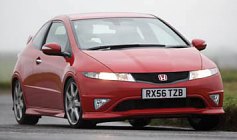 6
years have gone since the last generation Civic Type R was born.
Everybody expect the third generation to launch another revolution and
set new standards for hot hatches. Unfortunately, Honda is no longer an
engineering-led company that we used to know. Nowadays it fails to
build a car as good as NSX, nor it can repeat the success it enjoyed in
F1 racing during the late 1980s and early 1990s. In contrast, European
hot hatches are progressing rapidly. A few years ago, the Type R's 200
horsepower rating was deemed to be class-leading. Now this becomes only
a starting point for C-segment hot hatches. Rivals like Opel Astra OPC,
Seat Leon Cupra and Renault Megane F1 produce 230-240 horses. More
worrying, they produce nearly double the max torque of the Honda ! how
does Honda react ? 6
years have gone since the last generation Civic Type R was born.
Everybody expect the third generation to launch another revolution and
set new standards for hot hatches. Unfortunately, Honda is no longer an
engineering-led company that we used to know. Nowadays it fails to
build a car as good as NSX, nor it can repeat the success it enjoyed in
F1 racing during the late 1980s and early 1990s. In contrast, European
hot hatches are progressing rapidly. A few years ago, the Type R's 200
horsepower rating was deemed to be class-leading. Now this becomes only
a starting point for C-segment hot hatches. Rivals like Opel Astra OPC,
Seat Leon Cupra and Renault Megane F1 produce 230-240 horses. More
worrying, they produce nearly double the max torque of the Honda ! how
does Honda react ?
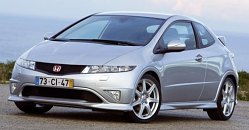 Look at
the spec sheet of the new Civic Type R, the answer is hardly promising.
The motor is essentially the same K20 2.0-liter i-VTEC with 11.0:1
compression ratio. Maximum output is increased by only 1 horsepower -
most likely to be a marketing trick - to a total of 201hp. Maximum
torque is even reduced by 3 lbft to 142 lbft. In order to compensate
for the weight gain of 67 kilograms, Honda has to lower the final drive
ratio in the new car. This mean the new Type R can barely return the
same performance as its predecessor - 0-60 mph takes 6.6 seconds, top
speed 146 mph. For comparison, Renault Megane R26 does 147 mph and 0-60
mph in 5.9 seconds. Seat Leon Cupra does 151 mph and takes 6.1 sec to
do 0-60. Look at
the spec sheet of the new Civic Type R, the answer is hardly promising.
The motor is essentially the same K20 2.0-liter i-VTEC with 11.0:1
compression ratio. Maximum output is increased by only 1 horsepower -
most likely to be a marketing trick - to a total of 201hp. Maximum
torque is even reduced by 3 lbft to 142 lbft. In order to compensate
for the weight gain of 67 kilograms, Honda has to lower the final drive
ratio in the new car. This mean the new Type R can barely return the
same performance as its predecessor - 0-60 mph takes 6.6 seconds, top
speed 146 mph. For comparison, Renault Megane R26 does 147 mph and 0-60
mph in 5.9 seconds. Seat Leon Cupra does 151 mph and takes 6.1 sec to
do 0-60.
Honda said there are numerous improvements to the K20. Firstly, it is
added with twin-balancer shafts to reduce vibration; Secondly, by
retuning intake manifolds and the i-VTEC mechanism*, the power delivery
becomes more elastic, where "elastic" means more torque at the bottom
end and freer revving at the top end simultaneously. If you look at the
torque curve, you will see it peaks at 5600 rpm instead of the previous
6500 rpm, while 90 percent of which is available from 2500 rpm instead
of 3000 rpm. Maximum power now occurs at 7800 rpm, some 400 rpm higher
than before. Engine cut-out is raised to 8000 rpm.
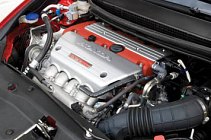 By the
standard of a 2-liter naturally aspirated engine, the above figures are
by all means impressive. You can't find any better one in the mass
production world, Renault Clio RS included. The problem is, most rivals
in the C-segment now employs turbocharging. Take Golf GTI for example,
it produces 207 lbft of torque from merely 1800 rpm. Step the gas and
the G-force builds up instantly. In the Type R under the same
condition, you have to drop one or two gears and wind up the engine
fiercely to squeeze every drop of performance out of it. You will enjoy
the process, because the engine is so sweet and eager into the VTEC
zone. Also, the slick and short-throw gearchange is first class,
encouraging you to use it as frequently as possible. However, if you
are not giving 100 percent effort, the Type R will feel nothing
special, rather like a regular family hatch. Even if you give 110
percent, it won't match the performance of its turbocharged rivals. By the
standard of a 2-liter naturally aspirated engine, the above figures are
by all means impressive. You can't find any better one in the mass
production world, Renault Clio RS included. The problem is, most rivals
in the C-segment now employs turbocharging. Take Golf GTI for example,
it produces 207 lbft of torque from merely 1800 rpm. Step the gas and
the G-force builds up instantly. In the Type R under the same
condition, you have to drop one or two gears and wind up the engine
fiercely to squeeze every drop of performance out of it. You will enjoy
the process, because the engine is so sweet and eager into the VTEC
zone. Also, the slick and short-throw gearchange is first class,
encouraging you to use it as frequently as possible. However, if you
are not giving 100 percent effort, the Type R will feel nothing
special, rather like a regular family hatch. Even if you give 110
percent, it won't match the performance of its turbocharged rivals.
Also worth to note, Honda has smoothened the power transition from slow
cams to fast cams by rewriting the ECU program. To some people, this
bring higher refinement to the driving. To the keenest drivers,
however, it has lost the sensation of the old engine. In the past, the
dramatic sound and power surge at the VTEC switchover was the trademark
of Type R. It was a bonus to the subjective driving experience. What a
pity Honda has sacrificed it in the name of progress !
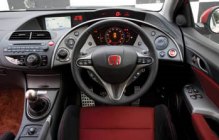 Having
finished the powertrain, we turn our attention to chassis. The new Type
R is built on the European Civic 3-door hatchback, which is produced
alongside it in the Swindon plant of UK. (Note: Honda moved the
production line of Civic Type R to UK since the last generation because
Europe is by far the largest market for hot hatches.) Compare with the
regular car, the Type R gets 20 mm wider tracks and 15 mm reduction in
ride height. The chassis has been reinforced around the floorpan and
front suspension towers. The electric power steering gets quicker ratio
– now it takes 2.4 turns from lock to lock. The brakes are upgraded to
300mm ventilated discs up front and 260mm solid discs at the rear.
Wrapping them are 18-inch alloy wheels and 225/40ZR rubbers. Having
finished the powertrain, we turn our attention to chassis. The new Type
R is built on the European Civic 3-door hatchback, which is produced
alongside it in the Swindon plant of UK. (Note: Honda moved the
production line of Civic Type R to UK since the last generation because
Europe is by far the largest market for hot hatches.) Compare with the
regular car, the Type R gets 20 mm wider tracks and 15 mm reduction in
ride height. The chassis has been reinforced around the floorpan and
front suspension towers. The electric power steering gets quicker ratio
– now it takes 2.4 turns from lock to lock. The brakes are upgraded to
300mm ventilated discs up front and 260mm solid discs at the rear.
Wrapping them are 18-inch alloy wheels and 225/40ZR rubbers.
In terms of weight, grip and steering response, the European Civic Type
R is superior to its American sister, Civic Si Coupe. On the downside,
it lacks the American version's limited-slip differential and
multi-link rear suspensions. The latter were replaced by a
semi-independent torsion-beam axle, basically a stiffened version of
the European Civic hatchback. Well, the loss of LSD does not present
much problems to the torque-less engine, but the downgrade of
suspension does harm the body control over bumpy surfaces. On B-roads,
the Type R does not settle as well as the multi-link rivals like Golf
GTI and Ford Focus ST. There are more body movements failed to be
filtered by the suspensions. Moreover, unlike the best European hot
hatches, the Type R has little throttle steer to play with. It just
grip hard until mild understeer intervenes at the limit. Backing off
the throttle does not induce any oversteer. Again, this is the outcome
of switching to torsion-beam suspension.
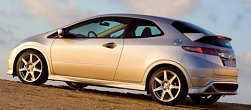 That
said, the ride quality and NVH suppression has been improved from the
previous generation. Besides, the electric power steering finally
delivers decent feel and consistency. The brake pedal also returns good
feel and weight. In short, with the exception of suspension, every
aspect of the chassis has been improved. That
said, the ride quality and NVH suppression has been improved from the
previous generation. Besides, the electric power steering finally
delivers decent feel and consistency. The brake pedal also returns good
feel and weight. In short, with the exception of suspension, every
aspect of the chassis has been improved.
Open the doors, you eyes will be impressed by the exclusive red and
black trim, Alcantara sports bucket seats, drilled aluminum pedals and
spherical aluminum gear lever. The spaceship-like instrument layout
makes more sense in this car than the regular Civic, as it adds to the
sophisticated ambience. The driving position is superb, but visibility
is poor due to the thick A-pillars and high-mounted rear window – now
rear visibility is further hampered by the rear spoiler. Good luck for
parking. Regarding the exterior design, it looks far more aggressive
than the old car from the front, but the rear view is rather disgusting.
Sometimes I wish Honda could go back to its engineering-led philosophy,
present us something more revolutionarily in mechanicals rather than
controversial styling or market-pleasing refinement. 10 years ago, it
already gave the first generation Civic Type R some very sophisticated
treatment, such as a VTEC engine with forged pistons and produced 116
horsepower per liter, all round double-wishbone suspensions with
reinforcing tower bars, limited slip differential, striped-out
chassis... 10 years later the Type R has taken no step forward. It only
polished the sharp edges and went mass market. In my view, Honda is
downgrading the Type R to make more business. That might be good to the
majority, but it hurts the prestige of the Type R name.
Remark: * As before,
the
i-VTEC mechanism combines the traditional 2-stage cam profile switching
VTEC and continuously variable cam-phasing VTC. In the new version, the
switchover point from slow cams to fast cams for VTEC is lowered to
5400 rpm. This mean the slow cams can focus on lower rev thus their
profile can be shaped to optimize low-end torque. On the other hand,
the fast cams have a more aggressive profile than the previous
generation. This improves top end breathing, hence higher rev and power.
|
| The
above report was last updated on 3 Feb 2007. All
Rights Reserved. |
Civic Type R (Japan)
|
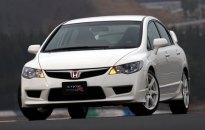 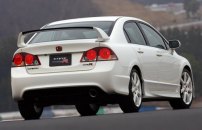 The European
Civic Type R has been a
disappointment to AutoZinists. So what about the Japanese version ? As
we know, the Japanese usually reserve the best for themselves – partly
because of their desire for technology, partly because their extreme
machines won't comply with EU or Federal regulations. Compare with the
Euro car, the Japanese Civic Type R differs in many aspects. First of
all, it is built on the 4-door sedan with longer wheelbase and
multi-link rear suspensions. The 3-box chassis is also inherently more
rigid than the hatchback. The European
Civic Type R has been a
disappointment to AutoZinists. So what about the Japanese version ? As
we know, the Japanese usually reserve the best for themselves – partly
because of their desire for technology, partly because their extreme
machines won't comply with EU or Federal regulations. Compare with the
Euro car, the Japanese Civic Type R differs in many aspects. First of
all, it is built on the 4-door sedan with longer wheelbase and
multi-link rear suspensions. The 3-box chassis is also inherently more
rigid than the hatchback.
Secondly, it looks much more handsome and sporty, thanks to a more
balanced proportion and a large rear spoiler. For those who dislike the
look of the European Type R like me, we have plenty of reasons to
choose the Japanese car. For the fans of the now defunct Integra Type
R, they have a good reason to stay at Honda.
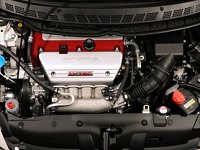 Thirdly, the chassis tuning is even more aggressive than
the European car. It has harder springs and dampers, larger brakes
(front: 320mm ventilated discs with Brembo 4-pot calipers; rear: 282mm
solid discs), lower ride height and, note this, a Torsen LSD as
standard. To compensate the weight increment, it deleted the sound
deadening materials, the spare tire, the power door mirrors… It also
converted the front bumper beam to aluminum, and the folding rear seat
to a fixed one. As a result, the Japanese Type R weighs much the same
as the shorter European car. Well done. Thirdly, the chassis tuning is even more aggressive than
the European car. It has harder springs and dampers, larger brakes
(front: 320mm ventilated discs with Brembo 4-pot calipers; rear: 282mm
solid discs), lower ride height and, note this, a Torsen LSD as
standard. To compensate the weight increment, it deleted the sound
deadening materials, the spare tire, the power door mirrors… It also
converted the front bumper beam to aluminum, and the folding rear seat
to a fixed one. As a result, the Japanese Type R weighs much the same
as the shorter European car. Well done.
Of course, the K20A engine is also higher tuned. From outside, it might
look the same. Underneath, however, it gets higher compression (11.7:1
vs 11.0:1), larger diameter throttle body, larger and straighter intake
manifolds (even with resin coating on the inner surface to reduce air
resistance, like the late NSX) and rerouted exhaust manifolds to reduce
back-pressure. The result is 225 horsepower by JIS standard at 8000
rpm, 159 pound-foot of torque at 6100 rpm, maximum rev is 8400 rpm.
That's 24 hp, 17 lbft and 400 rpm more than the European car.
On the Road
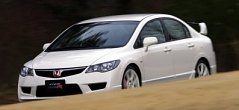 The Japanese Civic Type R is clearly designed for hardcore
drivers. Its engine output is focused at high rev, from 6000 rpm
upward, with a pronounced power kick once the VTEC system switched to
the fast cams. The loud exhaust note fills the uninsulated cabin. The
rev-happiness, the slick gearchange and the aural rewards encourage you
to squeeze every drop of horsepower from your right foot. The higher
the rev, the more excitement you get. In the Type R, everybody could
become a street racer. The Japanese Civic Type R is clearly designed for hardcore
drivers. Its engine output is focused at high rev, from 6000 rpm
upward, with a pronounced power kick once the VTEC system switched to
the fast cams. The loud exhaust note fills the uninsulated cabin. The
rev-happiness, the slick gearchange and the aural rewards encourage you
to squeeze every drop of horsepower from your right foot. The higher
the rev, the more excitement you get. In the Type R, everybody could
become a street racer.
Not only the powertrain, the chassis also performs like a race car. The
shocks from the road transmit to your bum directly. In return, you get
rock-steady body control. The steering – hydraulic assisted here rather
than electrical assisted – delivers direct feel to the driver's hand.
This car steers with precision and response surpassing the European
Type R. The front wheels grip hard on the road (thanks to LSD) without
any torque steer. When you come to stop, the Brembo brakes provide
powerful and confidence inspiring braking.
Provided you can live with its harsh ride and less tractable engine,
the Japanese Civic Type R is unquestionably the better car. More
important, it shows that Honda hasn't really gone soft, at least at its
home market. |
| The
above report was last updated on 11 Jul
2007. All Rights Reserved. |
|
|